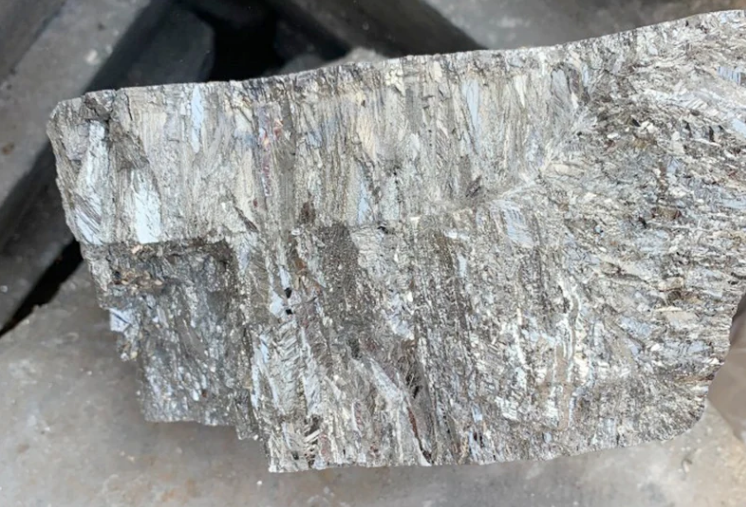Basic characteristics
High grade: The antimony content in antimony ore reaches 55%, which is a high-grade antimony ore. Generally speaking, the antimony ore grade is more common at around 10% - 20%. The antimony content of 55% means that the antimony element is highly enriched in the ore, and has a high mining and utilization value.
Mineral composition: The main mineral phase is usually stibnite (Sb₂S₃), which may contain a small amount of other antimony minerals such as stibnite (Sb₂O₃) and antimony chalcanthite. At the same time, it may be associated with other metal minerals such as pyrite, arsenopyrite, galena, sphalerite, and gangue minerals such as quartz, calcite, and feldspar.
Appearance characteristics: The color is mostly lead gray to steel gray, and the surface often has a blue tin color. It has a distinct metallic luster, and the crystal morphology may be long columnar, needle-shaped or plate-shaped, and the aggregate is often radial, cluster-shaped or dense blocky.
Resource distribution
Global distribution: Among the global antimony ore resources, antimony ores with an antimony content of 55% are relatively rare, but there are certain outputs in some famous antimony ore producing areas. For example, antimony ores with high antimony content have been discovered in Hunan, China, the Potosi region of Bolivia, and the Far East of Russia, among which some ores can contain antimony of about 55%.
Distribution in China: The tin mine in Lengshuijiang, Hunan, China is one of the important producing areas of such high-grade antimony ore. In addition, some antimony mines in Guangxi and Guizhou also produce ores with an antimony content of about 55%.
Mining and ore dressing
Mining method
Underground mining: For deeply buried antimony ore bodies with an antimony content of 55%, underground mining is often used. Through the excavation of vertical shafts, inclined shafts or horizontal tunnels, the ore body is reached for mining.
Open-pit mining: If the ore body is shallowly buried and close to the surface, open-pit mining can be used. This method has the advantages of low mining cost and high production efficiency, but the impact on the environment is relatively large.
Ore dressing method
Gravity separation: Utilizing the density difference between antimony ore and gangue minerals, through jig, shaking table and other equipment for separation, high-grade antimony concentrate can be enriched in advance and part of the gangue can be discarded.
Flotation: Generally, preferential flotation or mixed flotation process is adopted. Preferential flotation is to float out antimony minerals first, and then float out other associated minerals; mixed flotation is to float out antimony minerals together with other minerals with similar floatability, and then separate them.
Combined ore dressing: In order to improve the recovery rate and concentrate grade of antimony, a combination of gravity separation-flotation, flotation-magnetic separation and other ore dressing methods are usually adopted.
Use and value

Antimony metal production: It is a high-quality raw material for the production of antimony metal. After smelting, high-purity antimony metal can be obtained, which is used to manufacture various antimony alloys, such as antimony-lead alloy and antimony-tin alloy, which are widely used in batteries, chemicals, machinery manufacturing and other fields.
Preparation of antimony compounds: It can be used to prepare antimony compounds such as antimony trioxide and antimony pentoxide. These compounds are important chemical raw materials, especially in the flame retardant industry, and can be used to produce flame retardant additives for plastics, rubber, textiles, etc.
Strategic reserve value: Antimony is an important strategic metal. Antimony ore with an antimony content of 55% is a high-quality resource, which is of great significance for ensuring the security of national strategic resources and occupies an important position in the national strategic reserve.
Market price
Its price is affected by many factors, such as the supply and demand relationship of the global antimony market, the international price trend of antimony, the mining cost of ore, the difficulty of mineral processing, etc. Generally speaking, the price of antimony ore with an antimony content of 55% will be higher than that of ordinary grade antimony ore. In recent years, the price has ranged from thousands to tens of thousands of yuan per ton.
Environmental impact
Mining stage: It may cause problems such as surface collapse and soil erosion. Waste rock stacking will also occupy a large amount of land and may cause heavy metal pollution of soil and water.
Ore dressing stage: Ore dressing wastewater contains a large amount of heavy metal ions and ore dressing reagents. If it is discharged directly without treatment, it will pollute surface water, soil, etc., affecting the surrounding ecological environment and crop growth.
Smelting stage: A large amount of waste gas, such as sulfur dioxide, will be generated. If it is not discharged in compliance with the standards, it will cause air pollution and environmental problems such as acid rain. At the same time, smelting waste slag also needs to be properly handled, otherwise it will cause soil and water pollution.